Find your dream physical therapist job with this resume guide
This guide teaches physical therapists how to optimize their resumes to earn their dream job. Topics covered include choosing the right resume format, writing a physical therapist resume summary, selecting skills specific to physical therapy, and writing tips for work and education sections.
As a physical therapist, there are many qualifications needed to make you a fitting candidate for a position. When applying to jobs in physical therapy, you need to craft a resume that not only showcases your credentials but also reflects your drive and commitment as a physical therapist.
In this guide, we will teach you how to write the ideal resume as a physical therapist to help you land the job of your dreams and propel your career forward. You will learn how to:
- Choose a resume format that fits your experience level
- Write a resume summary that highlights your physical therapy skills
- Include both hard and soft skills to show off your diverse skillset
- Prioritize your most relevant work experience
- Include your educational and licensing credentials
- Create extra sections for certifications and awards
1. Choose a resume format that fits your experience level as a PT
When creating your physical therapist resume, there are two formats to consider: the reverse-chronological and the functional.
The reverse-chronological resume focuses on work experience, placing your most recent job first and working backward from there. While this is the most commonly used format and what employers expect to see, it can be a difficult resume to create if you lack a decent amount of prior experience.
The functional resume focuses on education, skills, and unpaid experience – removing the focus from work experience.
Generally, as a physical therapist, you want your resume to prioritize your work experience; however, if you are fresh out of school or training, a functional resume can help you fill in some of the gaps.
2. Write a resume summary that highlights your physical therapy skills
A resume summary is placed at the very top of the document and introduces you, as the candidate, to the employer. This type of summary can either be very beneficial when written properly, as it gives you the opportunity to hook the attention of the reader.
To demonstrate the difference between a weak and strong resume summary, here is an incorrect example with a corrected explanation:
Incorrect physical therapist resume summary example
"Physical Therapist with many years of experience working with a diverse pool of patients of all ages. Certified specialist in 3 different areas of physical therapy, offering clients a wide range of different services."
What's wrong with this example? The primary issue with this summary is that it is far too non-specific. When you are discussing your credentials in a summary, you want to be as specific and contextual as possible, as this will make it clearer to the employer what specialized skills or certifications you bring to the table.
Corrected physical therapist resume summary example
"Driven Physical Therapist with more than 6 years of experience working in a clinical office with age-diverse clients. APTA board-certified clinical specialist in 3 physical therapy proficiencies: Geriatrics, Pediatrics, and Neurology."
Why is this better? This example provides much greater detail and context surrounding the applicant’s experience and credentials. They name the exact certification they have, as well as their certified proficiencies.
3. Include both hard and soft skills to show your diverse abilities
Physical therapists work directly with clients, often needing to use physical treatment and intervention on patients. As such, having strong people skills is just as important as knowing the technicalities of treatment.
This means that on your resume you should include both hard and soft skills. Hard skills are your most technical abilities that require education and training to achieve, while your soft skills are your interpersonal abilities that make it possible to communicate and work with patients.
Best hard skills to put on your physical therapist resume
- Diagnostic equipment operation
- Electronic patient record management
- Healthcare treatment planning
- Physical stamina
- Tracking patient progress
- Determining patient pain tolerance
- Observing patients during exercise
- Scheduling
- Specialized technologies
- Knowledge of health and safety procedures
Best soft skills to put on your physical therapist resume
- Active listening
- Empathy
- Patience
- Emotional intelligence
- Motivation
- Positive/Calm demeanor
- Emotional support for patients
- Delegation
- Organization
- Stress management
4. Prioritize your most relevant work experience first
Your work experience section is where you get to showcase the actual work you have done in the field and the time you have spent with clients.
Physical therapy involves intimate interactions with clients who may feel vulnerable or uncomfortable. As such, employers look for PTs who have experience working directly with people and show a strong ability for communicating and working with the client effectively.
Physical therapist work experience section resume example
Physical Therapist | Chattanooga PT Specialists
Chattanooga, TN | February 2018 to January 2021
- Worked directly with over 35 patients following disease or severe injury, achieving restored function in a 12-month period.
- Developed a new therapeutic exercise program specifically for athletes with back injuries to help not only restore function, but prevent future injury.
- Earned more than 40 5-star reviews for patient and compassionate service, as well as a high success rate in restoring function quickly in patients.
5. Include your educational and licensing credentials
As a physical therapist, you may have a varying level of education depending on the level of your current PT position. The key when listing your education is to include your highest level or certification first, followed by any older relevant credentials.
Example of a physical therapist’s education section:
Education
- Doctor of Physical Therapy (DPT) | Standford University, Stanford, CA
- M.A. in Rehabilitation Services | Stanford University, Stanford, CA
- APTA Board-Certified Specialist in Sports Injuries
6. Create extra sections for certifications and awards
If you have earned several different certifications to become a more specialized physical therapist, including these on your resume is paramount. The general rule of thumb is that 3 or more certifications are worthy of their own section on your resume, placed near your education section.
Additionally, you may have earned a variety of local or regional awards for your service as a physical therapist. If this is the case, be sure to include these in a small additional section also place near the education section.

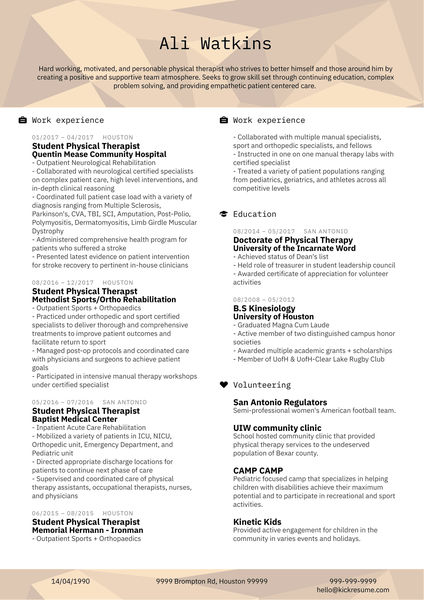


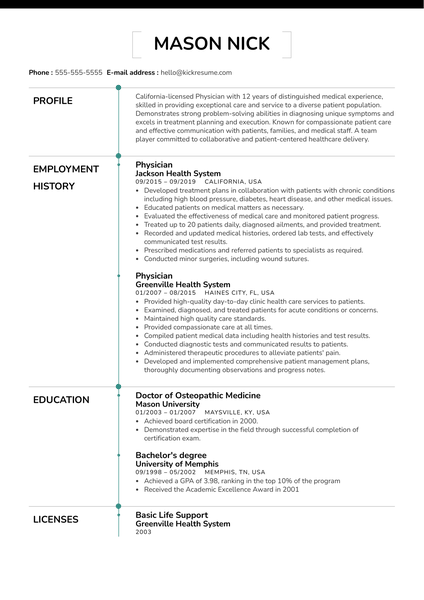

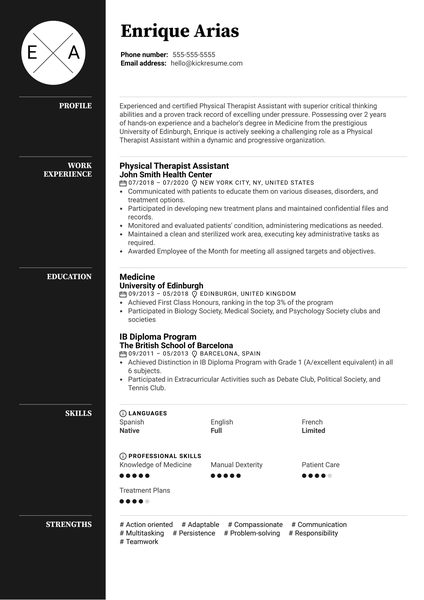

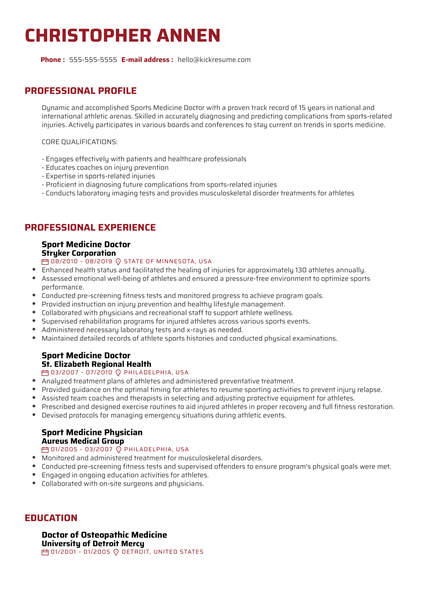
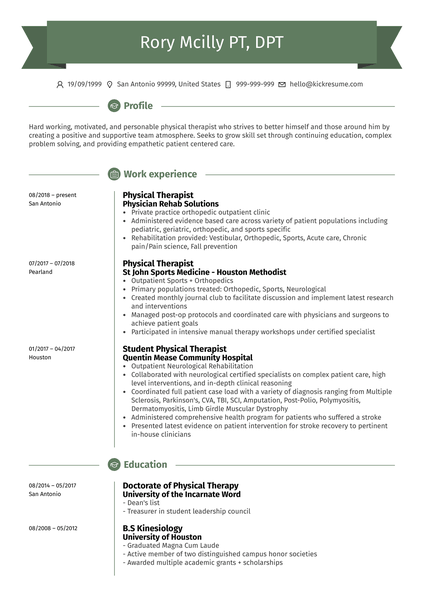

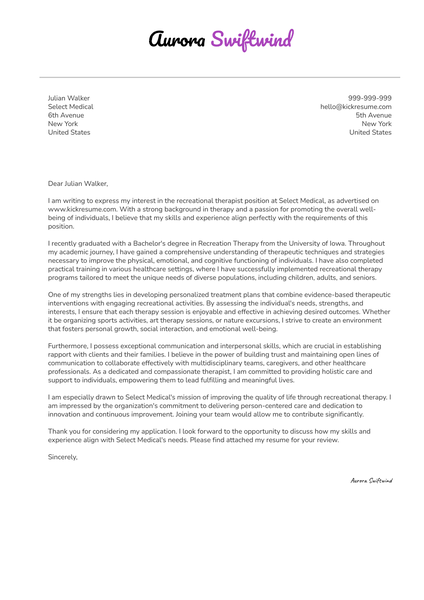
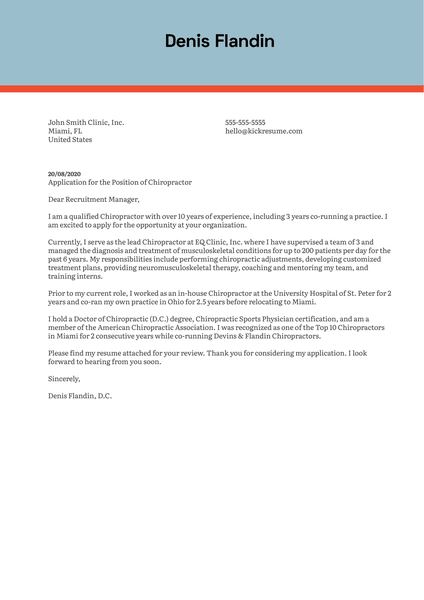
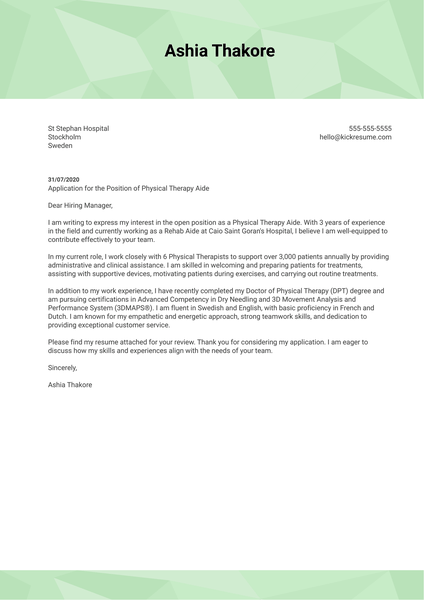
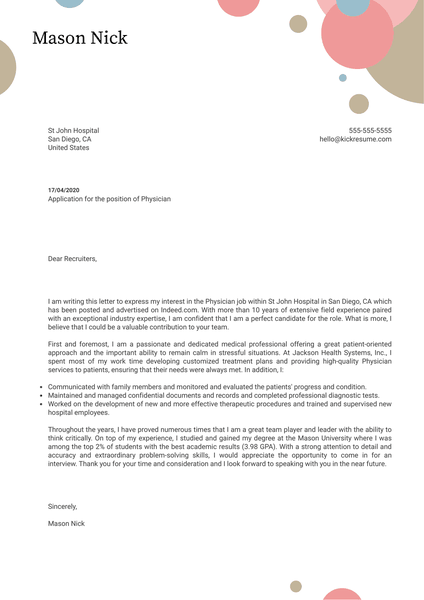
![How to Write a Professional Resume Summary? [+Examples]](https://d2xe0iugdha6pz.cloudfront.net/article-small-images/i-Profile.svg)
![How to Put Your Education on a Resume? [+Examples]](https://d2xe0iugdha6pz.cloudfront.net/article-small-images/i-Collage-Universities.svg)
![How to Describe Your Work Experience on a Resume? [+Examples]](https://d2xe0iugdha6pz.cloudfront.net/article-small-images/Experience.svg)


